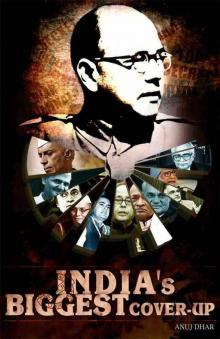Read India's biggest cover-up Storyline:
If he had not disappeared at the close of WWII, Subhas Chandra Bose could have led the free India instead of Jawaharlal Nehru. But die did he, Bose? For the last six decades, ever since the British disbelieved the Japanese announcement of their ally’s death in an air crash in Taipei and an American correspondent saw him alive in Saigon days afterwards, India's longest-running controversy has been raging almost non-stop. Was the Japanese news was just a smokescreen for Bose’s escape to the USSR? What does one make of his numerous sightings, the talk of his having been declared a war criminal and the surreal claim that he was working behind the scenes right up to the 1980s? India's biggest cover-up investigates the Bose mystery and its stranger than fiction subplots like never before. Relying on official records, archival material and information obtained under the freedom of information acts from across the world, the book uncovers a systematic obstruction of justice by the Indian establishment. It provides hitherto unknown facts and insights invalidating the air crash theory, supporting the line that Bose escaped towards the USSR with the Japanese help and pointing up a most interesting “Dead Man” angle. Augmented by over 200 images—of which nearly 90 are of still secret records—it runs you through 1945 to 2012 developments before making a pitch for comprehensive declassification to end the mystery. All along, the book: Takes you through the wartime investigations and the conclusions that the Japanese version was untrustworthy. Contrasts the Bose issue with the Wallenberg case; demonstrates why India's belatedly taking up the matter with Russia from 1991 onwards cannot inspire much confidence and dismisses Indian government’s secret assessment that it can’t ask the Russians about KGB records on Bose. Furnishes legally tenable evidence of foul play. For example, how the Intelligence Bureau in Nehru years doctored a vital document to support the official line. Throws light on the inglorious role played by Pranab Mukherjee, one of the most powerful politicians in India today. Relates the story of Bose's supposed remains and how the Government secretly started paying for its upkeep in a Japanese temple at the counsel of MEA official KR Narayanan, later the President of India. Recounts the secret tale of the loot of INA treasure by Bose’s former aides and a British officer who later became a renowned oriental art expert and was knighted. Enumerates a number of “conspiracy theories”—like that of an abortive military coup in the 1960s with linkages to “dead” Bose—and implores why they must be contained in India’s interest. Explains why Bose’s loyal aide Habibur Rahman Khan, who died after serving as the additional defence secretary of Pakistan, could have given out a false story. Revisits the intriguing Chinese angle to the Bose mystery. India's biggest cover-up dwells at length on the curious case of Bhagwanji, a cigar chomping holy man—who called himself “Dead Man”, was never seen in public but was believed to be Bose by many of his staunch followers. It explodes the myth that the negative DNA and handwriting tests carried out in government labs incontestably disapproved that Bhagwanji was not Bose. The book even tells you of Dead Man’s imagination defying claims—like he secretly participated in the Vietnam war—and assertion that his coming out would spell troubles for India. An AP picture showing a Bose lookalike during the armistice talks between the US and Vietnam in Paris has been included in the book to make your jaw drop.Pages of India's biggest cover-up :
